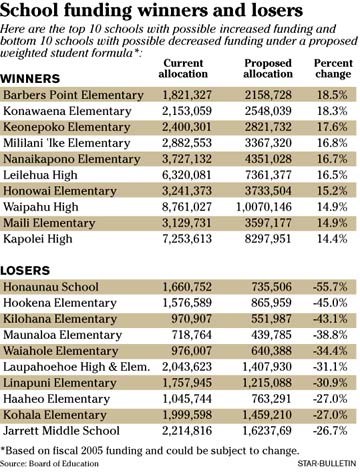Many schools
face big cuts
A BOE panel OKs weighted
budgeting, which changes how
funding for education is shared
More than half of public schools would see their budgets shrink -- some by as much as 50 percent -- under a new way of allocating state money based on students' needs that was unanimously approved yesterday by a Board of Education committee.
Also, 15 of the 24 high-poverty Hawaii schools under state-mandated "restructuring" for failing to meet requirements of the federal No Child Left Behind Act would see state funding cuts under the new system. They include Waiahole Elementary, which would see a 34 percent decrease, and Jarrett Middle School, where funding would drop 27 percent.
"It might be really difficult for some of these schools," said Breene Harimoto, chairman of the board's Ad Hoc Oversight Committee on the Reinventing Education Act. "And I'm still really concerned about implementation."

Harimoto and others said the new budget system will make school funding more equitable and uniform in contrast to the current system, which is a hodgepodge of formulas based on often outdated information.
"I do believe they (state Education Department officials) have come up with a methodology that makes sense, that's logical," House Education Chairman Roy Takumi told the board at yesterday's meeting. "It's a moral document that really reflects where you are as a board."
He also said the reality of the system change -- which uses the same $765 million pot but doles out funds differently -- is that there will be winners and losers.
Farrington High School, for example, would get a $1.2 million funding increase under the plan. Kaimuki High School would get $753,971 less, a 12.2 percent cut.
"Farrington is merely getting what they should have been getting all these years," Takumi said. "Kaimuki was really getting more than they should have."
The cuts and gains, based on a "weighted student formula," would not take effect until the 2006-2007 school year, with the effect spread over the next three years so schools have time to prepare.
The new system is designed to "weigh" the costs of a student's education and allocates more funds for students who are in poverty, who speak English as a second language or who are transient, as in the children of military members. More money is also allocated to elementary and middle school students, and those enrolled at multitrack schools.
Small and isolated schools get an added weight because they have higher per-student costs.
Office of Hawaiian Affairs Education Advocate Reshela DuPuis said she is concerned that the formula is cutting too much money from schools that need it most, including those with high native Hawaiian populations.
She said 16 of the schools undergoing "restructuring," which fared poorly on standardized testing criteria mandated by No Child Left Behind, have a large percentage of native Hawaiian students. Eleven of those will get cuts under the formula.
"We're talking about the ones that are really going to suffer," she told the board, adding that there should be exceptions made for schools with high-poverty students.
The system already excludes six special schools: Hawaii Center for the Deaf and Blind, Jefferson Orthopedic School and Pohukaina School, which serve special student populations; and Olomana, Keanae and Niihau schools because they are so small that the formula would skew their budget numbers.
A committee made up of teachers, parents, principals and others designed the formula. It is a key part of the Reinventing Education Act of 2004 and is also aimed at giving schools more say in how their money is spent.
The formula affects only state money; it does not change federal funding. The weighted formula would apply to nearly half of the Department of Education's budget and would affect most instructional costs but excludes programs such as special education and athletics.
Percentage-point losses range from the single digits to Honaunau Elementary's massive 55.7 percent decrease in funding. Kohala High School took a 27 percent hit -- the largest among high schools.
Randy Moore, project manager for the Reinventing Education Act, said that officials were considering the possibility of lessening some cuts or extending them over more years for certain schools. More information on the plan will be presented at the board's upcoming meeting, he said.
The big winners under the formula include Barbers Point Elementary, with an 18.5 percent increase, and Konawaena and Keonepoko elementary schools on the Big Island. Waipahu High school would get a $1.3 million gain, while Kapolei High School's budget would swell by just more than $1 million under the system.
E-mail to City Desk
[News] [Business] [Features] [Sports] [Editorial] [Do It Electric!]
[Classified Ads] [Search] [Subscribe] [Info] [Letter to Editor]
[Feedback]
